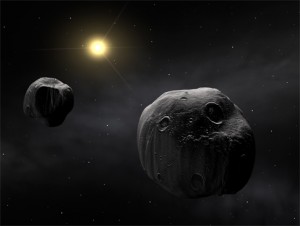Students are back… Binary Asteroid projects
Videos of talks
February 27, 2009from AO to NGAO (part I)
March 20, 2009Dear readers,
I realized that I did not post anything on my blog for a week. What was going on? Well I got caught in one we called a never-ending deadline series.
Last week, I started my UC-Berkeley week giving a lecture-class for undergraduate and graduate students on Tuesday. Then my student Brent came back from his road trip in the US and we started working together on his new project. Brent is finalizing the large table containing the characteristics of 165 reported multiple Asteroid systems. I want to make this work available through our PHP server at UC-Berkeley. It is almost done and I hope to be able to post a link soon on this blog. This is a major endeavor to which three generations of under-graduate students participated. It can be very tedious to search and check all parameters for binary asteroids (orbit characteristics, spectral type, etc…) but it also helps us to estimate what we know and don’t know yet about these asteroids. I was surprised to realize for instance that we have an integrated spectrum in visible (so an idea of their taxonomic class) for only 1/4 of them and a size estimate by radiometric measurements (from IRAS or Spitzer telescope) for only 1/5. In a few months, I would like to confirm a trend that we published in an abstract for the DPS 2008 conference. There is apparently a significant variation betwen the bulk density of asteroids and their taxonomic class. To summarize in a few words, M-type asteroids (assumed to be metallic) reach a density of ~3-4 g/cc, C type (assumed to have the same composition than carbonaceous chondrite meteorites) are lighter with a density ~1 g/cc and S-type (“rocky” asteroids) are an intermediate case (~2.2 g/cc). If this is true, it will be the first ambiguous confirmation of a relationship between the taxonomic class of an asteroids and its interior composition. So the good news is that we still have work to do and this completely justify the NSF grant that I received this year for this research.
I am blaming on Brent for keeping me busy:-), but I am glad to have someone to discuss and interact at UC-Berkeley. The planetary science department is very small, and even got smaller since my colleague, Mike Wong, left a few days ago for Baltimore. He is now working at Space Telescope Institute, specifically part of the WFPC3, the new mission scheduled to be mounted during the next Service mission (SM4). This is a great job for him and I wish him the best for this new position.
What else? I got news last week that ESO successfully recorded our observing on UT4. We requested time more than 1 year ago to observe (90) Antiope components spectroscopically using the Integral Field Unit SPIFFI mounted with the SINFONI Adaptive Optics system. In 2007, our group published an article and an ESO Press-release (PR) showing the orbit, shape and size (thus bulk density which indicates a rubble-pile interior) of this interesting and unique similarly-sized binary system. We conclude that most likely this double system formed by fission of a parent body, implying that the two components should have a similar composition. I hope these new comparative spectra of the two components will tell us more about this interesting possibility.
I am attaching a artistic view of the system which was specifically made for our Press-releease, It could be the way we will see Antiope system when we send a spacecraft to rendezvous.
Enjoy,
F.



